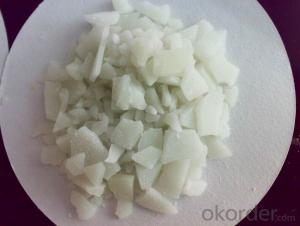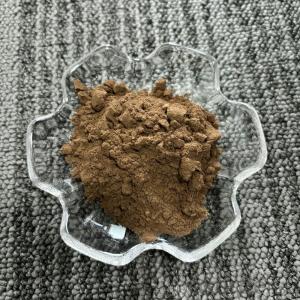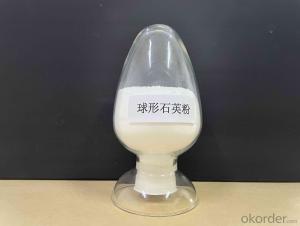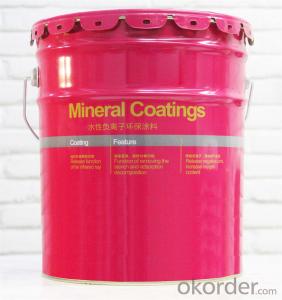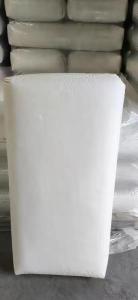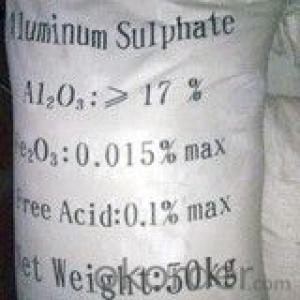Aluminum Sulfate Used For Paper
- Loading Port:
- Qingdao
- Payment Terms:
- TT OR LC
- Min Order Qty:
- -
- Supply Capability:
- 12000 m.t./month
OKorder Service Pledge
OKorder Financial Service
You Might Also Like
1. Chemical and Physical Properties:
Product name: Aluminium Sulphate or Aluminum Sulfate
Shape: Flakes or Granular or Powder.
EINECS NO.:233-135-0
CAS No.: 10043-01-3
HS.Code: 28332200
Molecular Formula: Al2(SO4)3
Appearance:It is white or grey flake,particle or massive crystallization.
Apt to cake after moisture absorption when laid in air for a long time.A little green because of Fe2+ ,yellow when Fe2+ is oxided to Fe3+.Soluble in water easily,and water solution is acid.
2. Specification:
Standard: HG/T 2225-2001 and HG/T 2227-2004
Items | Specifications | |||
I Type:Low Ferrous/Low Iron | II Type:Non-Ferrous/Iron-free | |||
First Class | Qualified | First Class | Qualified | |
Al2O3 % ≥ | 15.8 | 15.6 | 17 | 16 |
Ferrous(Fe )% ≤ | 0.5 | 0.7 | 0.005 | 0.01 |
Water Insolube % ≤ | 0.1 | 0.15 | 0.1 | 0.15 |
PH (1% aqueous solution) ≥ | 3.0 | 3.0 | 3.0 | 3.0 |
Arsenic(As) %≤ | 0.0005 | 0.0005 | ||
Heavy metal (Pb) %≤ | 0.002 | 0.002 | ||
3.Applications:
Water effluent treatment system
It's used for purification of drinking water and wastewater treatment by settling of impurities by
means of precipitation and flocculation.
Paper Industry
It helps in sizing of paper at neutral and alkaline pH, thus improving paper quality (reducing spots
and holes and improving sheet formation and strength) and sizing efficiency.
Textile Industry
It is used for color fixing in Naphthol based dyes for cotton fabric.
Other Uses
Leather tanning, lubricating compositions, fire retardants; decolorizing agent in petroleum, deodorizer; food additive; firming agent; dyeing mordant; foaming agent in firefighting foams; fireproofing cloth; catalyst; pH control; waterproofing concrete; aluminum compounds, zeolites etc.
4. Package:
Packaging Detail: PP/PE 50kg/bag;25kg/bag;Jumbo bag or according to customers' requirements.
20-25MT will be loaded in per 20'FCL container.
5. Attention and Storage:
The product is liable to absorb moisture and clot due to long-term exposure, so shady, cool and ventilated environment is needed.
- Q:What is the catalytic efficiency of ordinary chemical catalysts?
- Different reactions, with the same catalyst, the catalytic efficiency is different. The same reaction, with different catalysts, the catalytic efficiency is also different
- Q:What is the nature of the chemical catalyst?
- The nature of the catalyst is to play a catalytic role in reducing (or increasing) the anti
- Q:Name one case in which catalyst poisoning is useful?
- alkynes can react with hydrogen in the presence of a catalyst such as palladium to form alkanes, if they catalyst is poisoned you can produce alkenes instead
- Q:Is it not the rate to accelerate the addition of the catalyst to the catalyst, and that is why the balance does not move
- In the chemical equilibrium, after adding the catalyst, the positive and negative reaction rate increases equally, but the positive reaction rate is still equal to the reverse reaction rate, so the balance does not move
- Q:in acid-catalyzed reaction,there are some books show the acid catalyst as H+ and there are some show it as H3O+ .Are they the same?
- Sort of. If the reaction is under aqueous conditions (any water is included in the reaction), then yes, H+ = H3O+. This is because free protons present (H+) will be coordinated generally to molecules of water [thus H2O + H+ =H3O+ ]. But there are reaction conditions where water is not present, but an acid catalyst is still possible. In these cases, the acid catalyst may frequently be indicated as simply H+. Either way, the function in most of your reaction mechanisms is basically the same, whether indicated as H+ or H3O+ -- and that's to protonate molecules (Lewis or Bronsted bases) with H+. Concentrated sulfuric acid would be an example of a mostly-anhydrous (no water) strong proton/acid source (H+). Hydrochloric acid (HCl) frequently is available as an aqueous solution, even concentrated HCl is an aqueous solution of HCl. HCl itself is a gas under ambient conditions... but it has solubility in water and thus is conveniently sold frequently as an aqueous solution (which could be represented as H3O+)
- Q:Where are they good catalysts and why?? THanks!
- A catalyst is a substance that speeds up a chemical reaction by providing an alternate reaction pathway with a lower activation energy. Catalysts appear not to take part in the reaction. Frequently, catalysts are not very reactive. Acids and bases, on the other hand, are very reactive. Acids (as H+) and bases ( as OH-) sometimes function as catalysts in some organic reactions. They appear to be catalysts because in the course of the mechanism H+ or OH- is regenerated.
- Q:pls give one or two catalysts that are used in the industry for example:Rhodium catalyst in a catalytic converter of a car or the Iron catalyst for making ammoniaTHANKS :)
- i will tell you the hydrogen and carbonmonixide production in indsutry they will use alumina based nickel catalyst for adsorption of gases, at high temperature it will breaks as small molecules like hydrogen, co2, co,ch4, after they will separate them using carbon molecular seives as catalyst. another catalyst for hydrogenation of double bond is copper chromate for sulphur removal from disel and petrol they will use COMOX ( copper and molybdinum catalyst ) after then pass through zinc sulfide with hydrogen gas , the sulfur will removed as a hydrogen sulfide.
- Q:What is a catalyst?
- The catalyst can change the reaction rate (either fast or slow), but the catalyst itself is not affected before and after the reaction, that is, the quality of the same, the chemical nature of the same, itself has not changed.
- Q:Can a catalyst decrease the rate of a chemical reaction? Please give an example if yes.
- A catalyst is something that quickens the fee of reaction without getting used up itself. They many times try this by skill of lowering the activation skill, which additionally brings the optimal temperature down. So, to place it only, it relatively is B.
- Q:Before and after the reaction, the chemical properties and quality of the water did not change, and the water was the catalyst
- 6HI + 2Al = 2AlI3 + 3H2
1. Manufacturer Overview |
|
|---|---|
| Location | |
| Year Established | |
| Annual Output Value | |
| Main Markets | |
| Company Certifications | |
2. Manufacturer Certificates |
|
|---|---|
| a) Certification Name | |
| Range | |
| Reference | |
| Validity Period | |
3. Manufacturer Capability |
|
|---|---|
| a)Trade Capacity | |
| Nearest Port | |
| Export Percentage | |
| No.of Employees in Trade Department | |
| Language Spoken: | |
| b)Factory Information | |
| Factory Size: | |
| No. of Production Lines | |
| Contract Manufacturing | |
| Product Price Range | |
Send your message to us
Aluminum Sulfate Used For Paper
- Loading Port:
- Qingdao
- Payment Terms:
- TT OR LC
- Min Order Qty:
- -
- Supply Capability:
- 12000 m.t./month
OKorder Service Pledge
OKorder Financial Service
Similar products
New products
Hot products
Hot Searches
Related keywords
